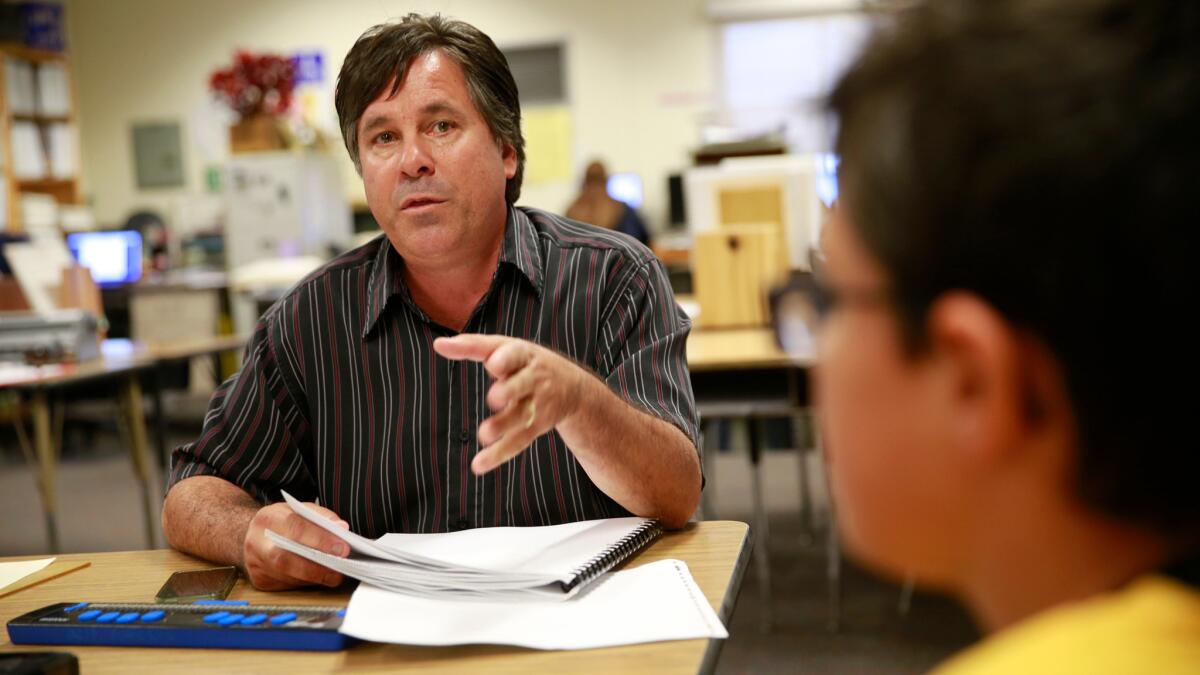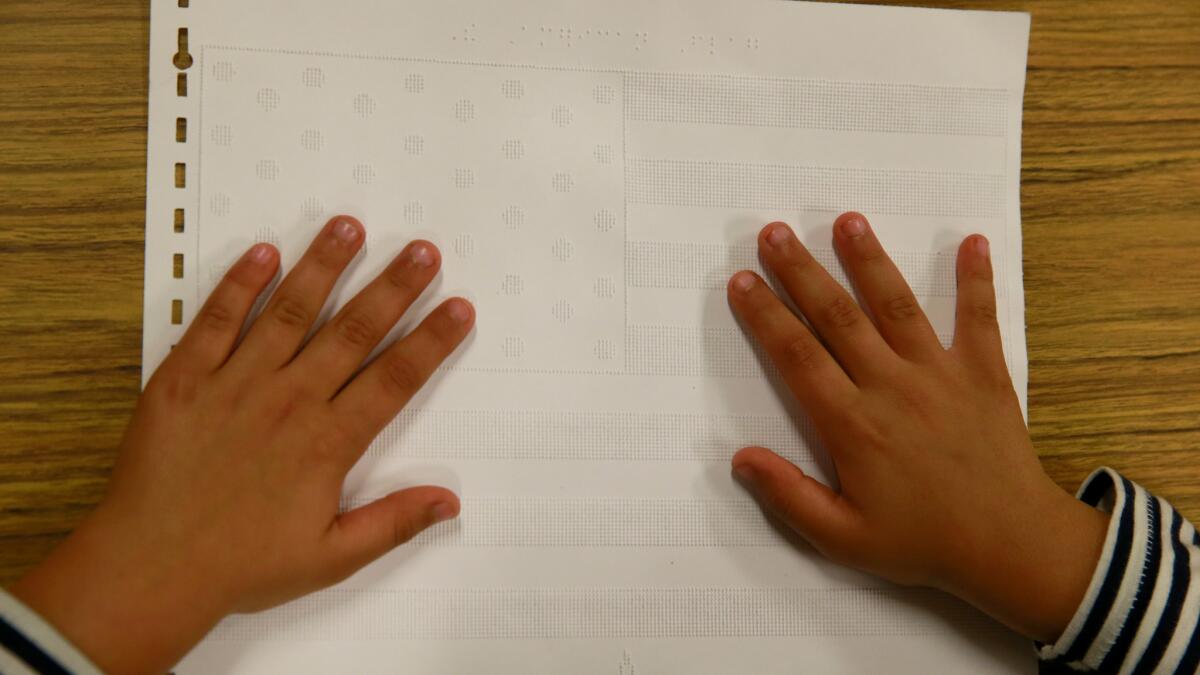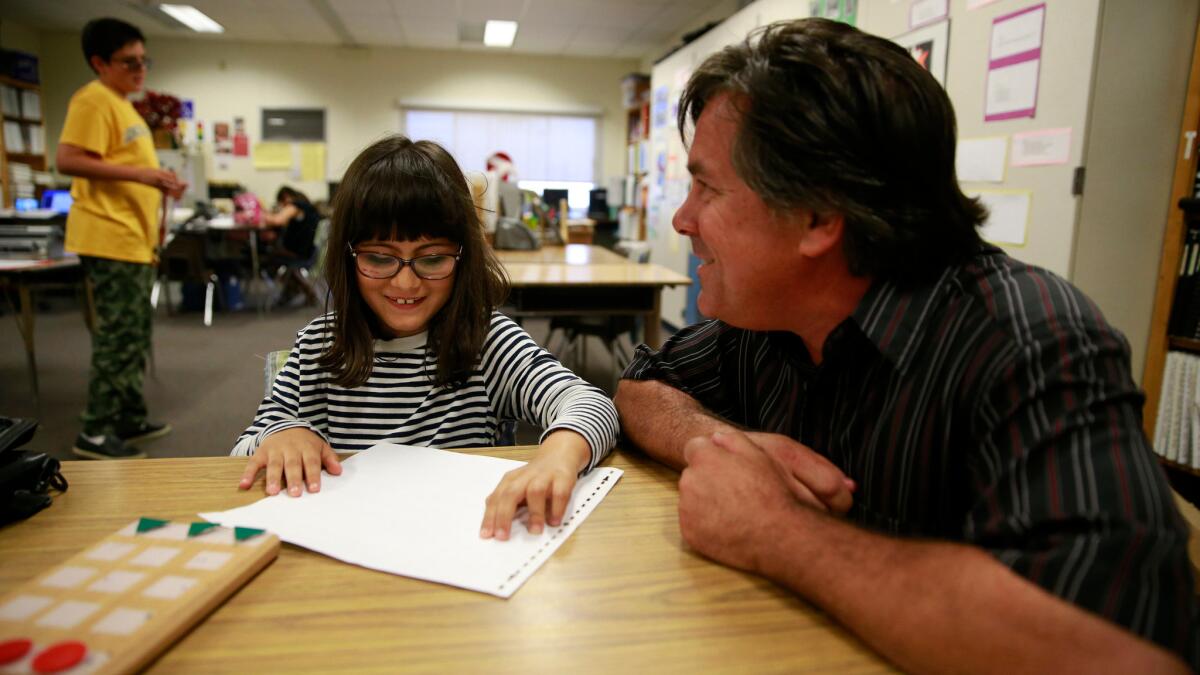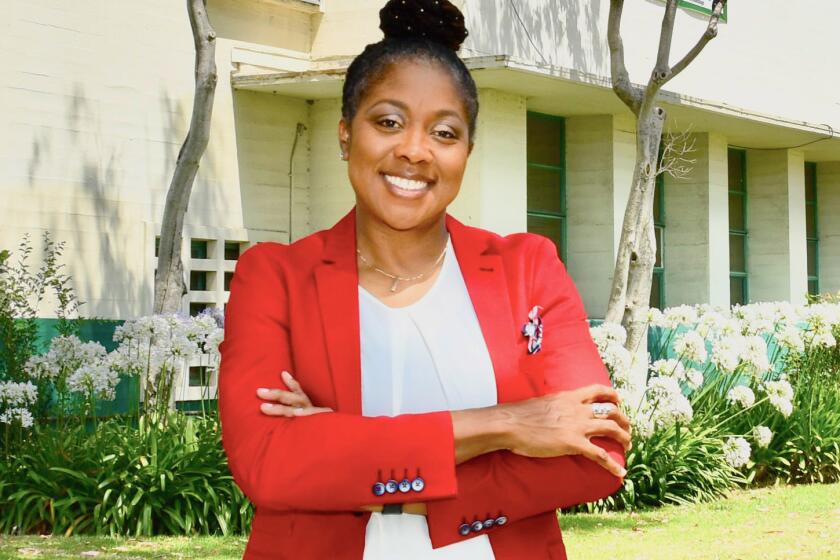How to live blind and bold — a Braille teacher’s lesson plan for life

Anaheim — Open the door and announce yourself. That’s the rule for students entering Keith Christian’s classroom.
They step inside and hear the pitter patter of paws on the carpet as Whitney, a black labrador, brushes against their legs.
If they reach to the right, they feel thin cylinders bedecked with balls, the canes that help them sense objects instead of walking into them. They might also hear the scratch of a 3D printer, the strum of a guitar, the gentle clacking of fingers on a Braille keyboard.
This is a rare classroom, in which both teacher and students are blind or visually impaired.
Christian has been teaching such students at Clara Barton Elementary School for over a decade.
He sees them between their regular classes, one-on-one or in small groups, and teaches them how to read, write, surf the web, play video games in Braille.
In and around the classroom he designed, they learn how to run, shape wood, assemble foods to cook. Different work areas are filled with computers, musical instruments and a portable kitchen.
This year, the Braille Institute named Christian the National Braille Teacher of the Year, the first totally blind teacher to earn that title.
He’s quick to change the subject. He’d rather talk about his students and his goals for them.
“A lot of blind kids listen to radios,” Christian said. “I like to give them a craft, something they can do with their hands. I want to give the sense of: I can make it, I can build it, I can do it.”
He believes in a constant broadening of horizons, of which understanding Braille is a part.
But Christian’s honor comes at a moment when fewer blind or visually impaired students are learning Braille — only 8.5 percent of them — as the use of software that turns written material into audio soars. Some programs report having difficulty recruiting new instructors for blind students.
Christian and organizations representing the blind say without Braille, their students will never have the same tools as their sighted peers. They won’t be able to situate a sentence within a paragraph. They won’t be able to edit a document in an office. They might not know how to spell their own names.
I like to give them a craft, something they can do with their hands. I want to give the sense of: I can make it, I can build it, I can do it.
— Keith Christian

Keith Christian is teacher of the year 2016 for excellence in Braille instruction at Barton Elementary School in Anaheim.
Christian, who grew up in Garden Grove, was born with retinitis pigmentosa, a condition that as a child gave him low vision but sight enough to learn how to read big print.
It was only in college, at Cal State Fullerton, that he realized he had to learn braille. He was spending hours with his face pressed close to a video monitor as a video magnifier projected enlarged images onto a screen. His eyes had started burning badly. Something had to change.
So he started to learn braille. “It took a long time,” he said. “I think it has a lot to do with why I’m here.”
He spent seven years teaching at Nobel Middle School in the Los Angeles Unified School District and moved back to Orange County when his parents got sick.
Christian became a teacher, he said, because he hoped to help children avoid his steep learning curve. He also wanted to have summers off with his kids, and he was lucky enough to be near his son and daughter during the year too, while they attended the school.
Nothing, he said, beat the feeling of standing outside his classroom door, feeling his son’s arms around him, hearing, “I love you, daddy.”
At Clara Barton, Christian’s students are mainstreamed, meaning they spend most of each day in classes with their peers, learning from the same curriculum. With younger students, he spends time teaching them to discriminate between shapes with their hands, track straight lines so they can eventually scan text, and orient their hands so they can figure out which dots are raised and what letters they form in Braille. Older children come to him when they need help with their Braille readers, or writing an essay, or when they simply want to jam by his side in the music corner.
From the beginning, he has gone above and beyond to equip his students with skills. At Nobel, he got the idea to teach his students wood shop — but first, he had to learn. When he asked for lessons, the shop teacher initially demurred, scared of giving a blind man a table saw.
The teacher gave up when Christian informed him that he would be using a table saw anyway and he was giving his colleague the opportunity to show him how to do so safely. Since then, Christian has built many things, guided by online blind woodworkers groups. Now, he has a table saw, band saw and lathe at home. After he cuts boards, his students use files and rasps to shape them. They sand the parts, glue the joints, clamp them together and apply finish.
Christian’s classroom showcases their labor. Braille text takes up more space than print, and students had trouble fitting books inside their desks. To solve the problem, they built vertical wooden desk shelves. Later, they added legs underneath the shelves to make room for the Apex, a small black Braille keyboard that connects to the Internet. Students place their fingers atop the keys and feel pins move up and down against their skin, forming each line of text.

Christian wishes he could have learned Braille earlier in life, as his students are doing. “It would have been an entirely different experience,” he said. It would have made reading easier as his vision dimmed.
According to the nonprofit American Printing House for the Blind, in 2014, about 60,000 students in the U.S. were blind. Only 5,147 of them were primarily Braille readers.
Fourteen percent of adults with visual disabilities had college degrees in 2013, according to the National Federation of the Blind, and 32 percent had a high school diploma or GED. Just over 40 percent of working-age adults with significant loss of vision were employed in 2013.
It’s hard to find anybody who argues against teaching Braille. But many people now believe “the myth that current technology can replace Braille,” said Chris Danielsen, a spokesperson for the National Federation of the Blind. He contends that students who have some vision should be taught Braille in school, because, like Christian’s, their sight likely will decline. But it’s sometimes seen as easier, cheaper and more efficient for a school to just teach them print with the help of audio tapes and magnifiers.
Federal law requires Braille to be available to students who need it, unless teachers deem it inappropriate — but that law has never been fully funded.
One reason for Braille’s current decline may be the growing number of students with multiple disabilities, said Yue-Ting Siu, a Braille educator and consultant. In the 1950s and ‘60s, she said, many students who were classified as blind identified as typical in other ways. But now, she said, more students with visual impairments have cognitive disabilities that make it harder for them to absorb language.
Siu is about to become director of San Francisco State University’s program that trains teachers for the blind, one of two such training programs in California. Together, they produced 208 graduates between 2011 and 2015 in a state in which 3,670 students listed visual impairment as their primary disability in December 2015.
“It’s an area that not a lot of people know about,” Siu said. “It’s really hard to recruit smart and creative people.”
The Braille Institute organized the teacher of the year competition in 2007 to try to get the field some attention, though offerings were lean when it solicited nominations. Most years, the average number of nominees was six, said national programs director Sergio Oliva. This year, 13 were nominated. .
And if it’s hard for districts to find qualified Braille teachers, it’s also hard for a Braille teacher to get enough time with students to teach them all they need to know.

Christian wants his students to feel unlimited.
Some are scared of running because of the risk of bumping into things. Christian split a ski pole in half to make it easier to pound it to the ground. Then, he attached a tether and had students hold it while walking around the pole. They followed the circumference of a perfect circle, with the pole at its center, whose path they knew to be clear. After walking became running, Christian added bases so students could better understand the arcs of their runs.
Christian’s classroom bases are smoke detectors — shock absorbent, so students can develop muscle memory. They emit a variety of beeps which helps runners figure out which bases they’re on.
Bases in place, Christian added a kickball.
Eventually, some students dropped the tether.
Brennan Lamarra, 12, a loquacious kid from Fullerton, said he benefits from Christian’s hands-on lessons. One recent day in Christian’s classroom, while editing an essay on an outdoor science field trip, he dreamed up a design for a mahogany cheese board.
Christian and Brennan go way back. Christian taught Brennan the Braille alphabet back when he was in preschool. “What other teacher would spend seven years with a student?” Brennan said. “He’s really into technology. Half the things in here talk.”
Brennan’s sister, Mina, 8, is also a disciple of Christian’s. Her favorite part has been woodworking. When she started shaping physical objects, she said, “I didn’t know what was going to happen.” Now she’s so sure-handed, she recently made a giraffe.
When Mina grows up, she wants to be a secret agent, she says, as Whitney dozes by her feet. Because she’s stealthy. Because people will look at her and think she’s blind so she can’t do anything.
Thanks to Christian, she knows better.
ALSO
‘Get to green:’ California wants to grade school performance with colors instead of a single number
Legendary East Los Angeles educator Jaime Escalante honored with his own commemorative stamp
More to Read
Sign up for Essential California
The most important California stories and recommendations in your inbox every morning.
You may occasionally receive promotional content from the Los Angeles Times.











